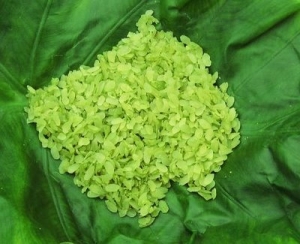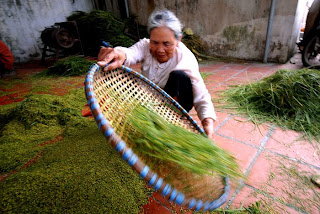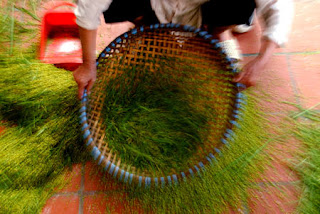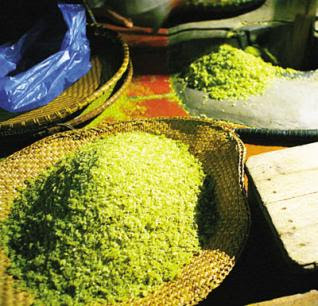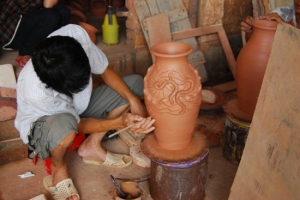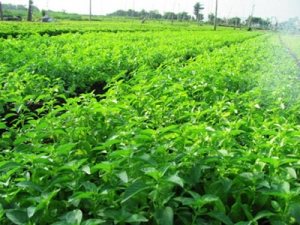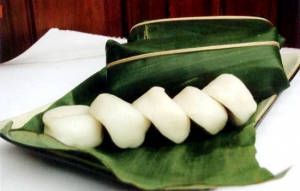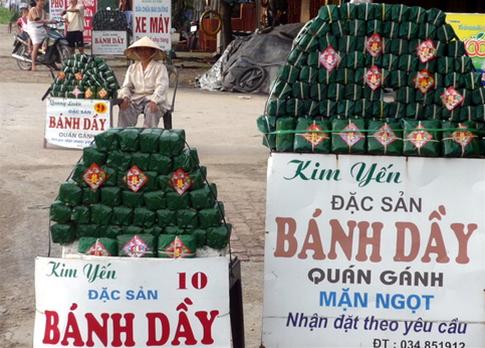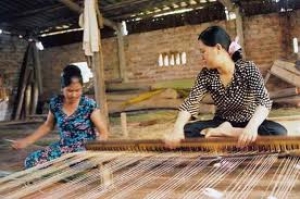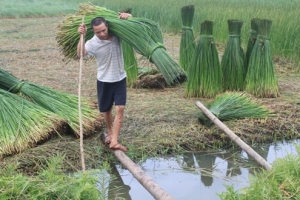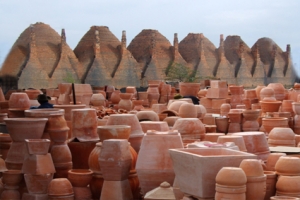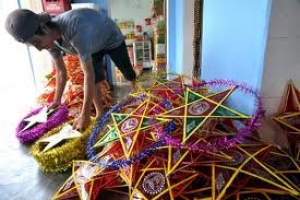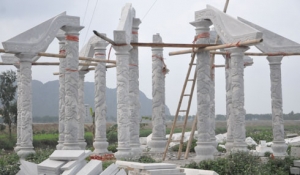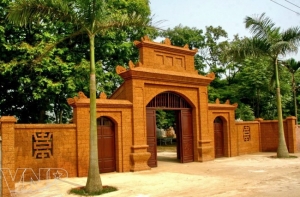
Asia Pacific Travel Team
Vong village - a famous trade village in Hanoi
Come to Hanoi, who do not remember a famous appetite present that tender rice . The first gift has just recently that gracious called "Cốm of Vong village”
Vong Village includes the villages: Vong Tien,Vong Hau,Vong So,Vong Trung but only two villages: Vong Hau and Vong So make delicious Cốm.
Come to Hanoi, who do not remember a famous appetite present that tender rice . The first gift has just recently that gracious called "Cốm of Vong village”
The early autumn, walking in the area we see sweet growing rice break season alternating with grass smell, smell of home. Village people go round and break the rice for 24 hours to hand in the processing of the paddy seeds to Cốm.Making Com is not simple. Method of communication is always confidential: only the parents transmitted to the son, not to most people for the daughter because when you go get her husband's daughter will bring method to cook the other.
Talk about how make Cốm, of course many areas of the country that must recognize that no where do seeds cốm flexible and delicious in the Vong villages. People of Vong village who cook very elaborately. Type rice snow rise seeds that type make Com.There are many types: sticky fat varieties, Japanese sticky, flowers yellow sticky, sticky stations first, then ... Rice's daughter and then exposed to color. Then wait to ensure the rice grains (but is certainly green, not red, yellow) on the cut. Rice cutting on absolute or may not be beating, but pluck to golden paddy seeds leave. People that: secrets of the time with cốm take in the island said. All skill plus experience helped traditional village for cốm Vong very flexible, always have a fire, especially wood heater must be first special wood not used to wood or wood straw spots. The consequent need to lastly mirror light, thoroughly; pestle is not too heavy, which is all hands must not be delayed because cốm calming.
After completed, it will take to improve in the light most seeds cốm (cốm is the first fork). While the second cốm cốm is often all but three is not to complete the food is right, need to go through a stage is a more.
They get the rise seeding grind , socialize with water make a product green color and leaves them to cốm true for all hands. Once they finished, com is in a very thin piece of the banana leaves or lotus leaves and then assigned to bins load going to sell. Blue natural cốm plus artificial blue as a blue village for cốm Loop. Com village with a very thin, and the number of hands is appeased for the flavor of the rice.
Making cốm industry is very hard, a late, two early. The girls soon every Vong village the full Com load for sale. Com Vong cosset be sold from the hands pair of her village by village women as the salty, aromatic flavor com.
To enjoy the full flavor of cốm we must eat com, not include anythings. And not cốm have long been a popular food can not be lacking. In addition to eat, people still processing cốm many other dishes. First cốm itself. Cốm because a food may not be long to think of how compressed cốm, not to cốm landmark but still flexible and delicious.
After this, people do the pie, grilled job media has thought out and a cốm grilled (pig grilled with cốm) eat dust, fat and fragrant. It is said that father cốm time to eat hot new enjoy the taste of it.
Phu Lang, a traditional pottery village
Phu Lang, a traditional pottery village in Dai Lan, Que Vo, in northern Bac Ninh Province creates pieces that capture the heart and soul of Vietnam.
Phu Lang Pottery Village is located in Phu Lang Commune, Que Vo District, Bac Ninh Province and about 60km from northeast of Hanoi. Phu Lang craft village is situated at the poetic Cau River. It impresses tourists with its simplicity. Among dozens of craft villages in the Cau River area, the cradle of the Red River civilisation, Phu Lang is well known with many ceramic artisans. For years, the village seemed unchanged. However, since the Saint Patron of ceramics making, Luu Phong Tu, brought the craft from China to Phu Lang and taught his children and co-villagers to make ceramic articles, dozens of generations of craftsmen have settled in Phu Lang and earned their living by practicing this occupation.
Many tourists like travelling to the village because they have a chance to make ceramics themselves. Clay, the materials used to make ceramics, is bought from other places and transported to the village by boat. Tourists to the village can stay at villagers’ homes to enjoy the peaceful atmosphere, see the ceramic kilns mushrooming along the dykes or on the low hills near Luc Dau Giang, facing the Cau River which runs all the year round. For years, Phu Lang ceramic ware has been on sale together with those ceramic articles made in Bat Trang, Tho Ha, Huong Canh, Phan Thiet, Dong Nai and Mong Cai, other well-known ceramic making areas. However, the products of Phu Lang are much sought after by customers throughout the country due to their durability, diversity and unique enamel colours of eel skin, purple, pink, black, yellow, frog skin,... A special enamel, called shrunk enamel, is only made by these two artisans. At different temperatures, this enamel produces different natural designs and diverse items which greatly attract buyers.
Phu Lang ceramic products are of high quality because they are dried in the traditional kiln called the Rong, which is specially constructed and uses dry wood as fuel. The kiln is built in the shape of a lying fish, 2.3 m (at the widest point) and 1.8m (at the narrowest point) in width and 2.5m (tallest) and 1.8m (shortest) in height. There is no support pillar inside. The kiln vault is made of brick. On average, one batch includes 700 main products, such as jars, basins, pots,... and 1,000 -1,500 extra items such as bottles, water troughs and pots to cook traditional medicine. The products are tempered at more than 1,000ºC. It is because of the result of the high temperature-resistant red clay, the finished products are not deformed after being fired and baked. Phu Lang ceramic products have quickly found a niche in both domestic and foreign markets, including the Netherlands, Denmark, England, Sweden and Thailand.
Phu Yen's unforgettable vegetable village
Ngoc Lang is known as a peaceful village with vegetable fields that are as green as jade stones.
The village is compared to a child protected and nurtured by two mothers that are the Chua and Ba rivers. Silt of the two rivers has raised the level of its land. This has allowed Ngoc Lang to become the village providing the largest amount of vegetables in Phu Yen Province. With fertile land and knowledgeable villagers, the vegetables of Ngoc Lang village are also sold throughout Vietnam.
Locals grow vegetables year round except in September and October due to the rain season.
At only 4am, when the whole city is not yet awake, locals head to the fields to care for their vegetables. Some growers harvest vegetables and some work on land.
The flood at the end of 2009 destroyed all vegetable fields. However, one year later, the vegetable fields have once again grown thanks to all effort of hard-working growers.
Lying near National Road 1A and the North-South railway, through windows, passengers can have a chance to enjoy vast vegetable fields on which growers with white conical hats are working.
It is a serene sight that makes passengers forget about the long journey and reflect on the beauty of the village and its villagers.

It’s difficult to see boundary of vast green vegetable fields. From a far distance, there is Nhan Tower, which is a tourism site of Phu Yen Province
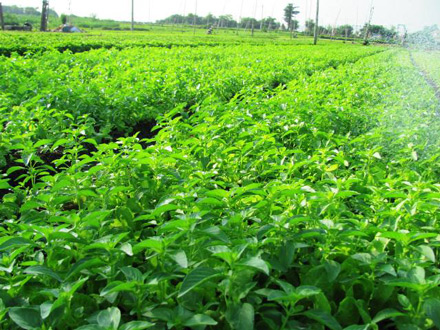
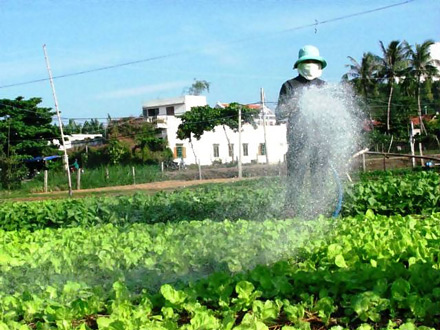
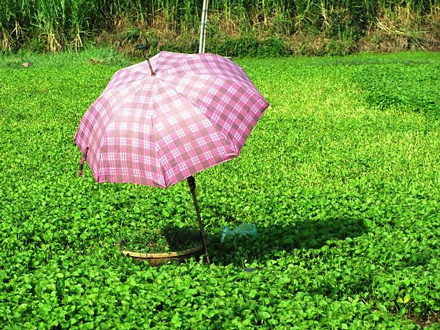
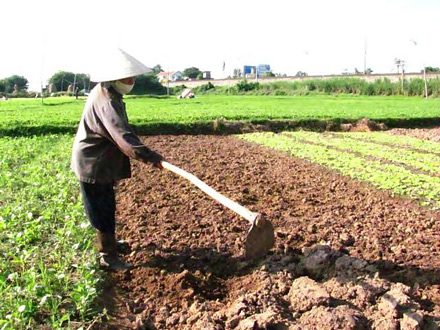
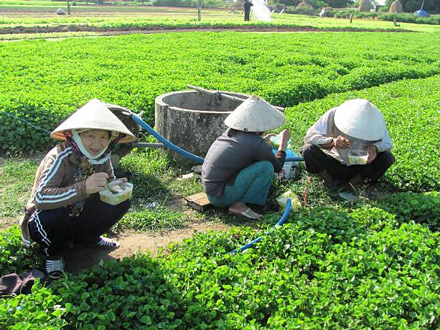
Growers here often have breakfast at the field because they have to wake up very early to work
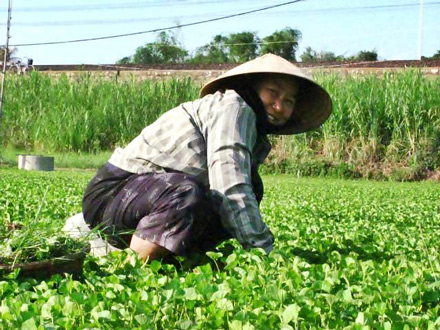
Smile of Ngoc Lang’s villager
Quan Ganh village serves best "Banh Day" - Glutinous rice cake
Quan Ganh Village is famous for its traditional cake called "Banh day", a delicious treat of glutinous rice cand green beans wrapped in banana leaves. Almost all people who pass this area stop to buy some couples of “bánh dày” as souvenirs for their beloved or simply as their lunch, a famous specialty of Ha Tay land. This cake has been popularly loved and enjoyed by lots of people, both Vietnamese and foreigner tourist who travel to Vietnam though they just pass by and try it by chance.
Located along National Highway No.1 in Hanoi's Thuong Tin District. Quan Ganh village is worth for a visit just to sample some of the local Banh Day or Day cake.
Day cake is similar to chung cake, which is eaten during the lunar year, but day cake is a popular snak throughout the year.
Chung and Day cake are closely connected to Lang Lieu, a Vietnamese prince. According to legend, a beggar once came to Quan Ganh. The villagers did not drive him away, and instead fed him a hearty meal. In return, beggar taught the villagers how to make Day cake. From then on, villagers have been enjoying the snack.
Quan Ganh village makes the best Day cake in Hanoi, an it can be easily found on sales by treer vendors for just a few thousand Vietnamese dong.
This cake is made with a special kind of glutinous rice which can only be planted in Hai Hau (Hải Hậu), Nam Dinh (Nam định) province. It is greatly fragrant and glutsive role in making good cakes.
Dinh Yen mat craft village
Dinh Yen Mat craft village is located around 33 kms from Sa Dec Town of Dong Thap province. This is an attractive destination for Vietnam travel. The village which is by the side of Hau River, has been famous for its traditional mat-making craft which has existed for nearly 100 years.
About Vietnam travel - Visitors to Sa Dec Town in the Mekong Dlta province of Dong Thap can admire gardens full of colorful flowers in spring time or visit Huynh Thuy Le House where French hit movie L’amant (The Lover) was filmed. But there is another side to this area of the delta and tourists should take time to have a look at Dinh Yen sleeping mat craft village in Dinh Yen Commune, Lap Vo District.
Located around 33 kilometers from Sa Dec Town, the craft village lies along the bank of Hau River. Through the passage of time and industrial development, the village has stood strong for almost 100 years and it is a source of pride for locals and an attractive tourist site.
For a long time, sleeping mats were a way of life in Vietnam. People still use the mats to sleep or sit on and not only in homes as they are used in religious ceremonies or sacred places or festivals. In Vietnamese culture, a beautiful sleeping mat is very important for newly-weds and the mat is considered part of many love stories.
The main material to make sleeping mats is lat trees. Every household, in the village, has one or two weaving looms. The craft is handed down to younger generations in the craft village. It is a fascinating spectacle for visitors to see the whole family gather to make mats as they choose lat strings to dry, weave and decorate.
Coming here, tourists will have a chance to attend the village’s market where millions of products of different kinds from the Cuu Long River delta and the eastern area of Southern Vietnam are exchanged every year. Particularly in the last month or the first and second months of the year of the lunar calendar, mats are much sought-after. One of the most outstanding features of the market, different from those in other regions, is that buyers will stay at a place to wait for sellers who carry products on their shoulders.
Another unique feature of the market is that the market is held at night for two hours because the locals arebusy weaving mats all day long and they only go to the market at night.
The market is always animated with young female sellers who enthusiastically introduce to customers various kinds of mats, diverse in colours and patterns. Prices vary widely and a lot of bartering can be seen going on.
In An Le Hamlet, the family of Ho Thi Muoi has an age-old tradition of making mats. Her 70 year-old mother and daughter Vo Thi Tu Trinh, 22 years old, diligently weave mats. Muoi said: “Nobody knows when the mat-making craft was established in the village. At present, almost households in the hamlet participate in the craft after harvest time, helping to provide a stable income.”
In the wharf are hundreds of boats and junks of traders from different provinces who go to the market to buy mats. Each trader buys 500 to 1,000 mats to sell all over the watery area of Cuu Long River. The market is also the place where mat-making materials from Sa Dec, Vinh Long, etc., are sold.
Visiting the market, tourists will be impressed by an exciting atmosphere of the market on the yard of An Phuoc Pagoda. It will be an excited experience for tourist travel to Vietnam as well as impressed travel spot of tours in Vietnam
Hong Tam
(Collection)
Nga Son in sedge season
Being well-known for beautiful sedge mat for centuries, Nga Son (Thanh Hoa, Vietnam) is always bustling in harvest season: the animation of the local residents together to harvest sedge and the exciting images of sedge drying a lot from the fields to the yards of each family.
Most Vietnamese know well the idiom, “Nga Son mats, Bat Trang ceramics” which signifies the popularity of these two locations.
There are many provinces planting sedge for mat making and various kinds of handicraft, but sedge in Nga Son is always considered best quality because of its soil condition. The sedge is not only long but also naturally white and free from black spots caused by stem borers.
Thousands of farmers engage in various stages of mat making, from spining, dyeing and drying, to weaving. Many co-operatives and enterprises like Viet Trang, Nga Son were established with hundreds of workers busily weaving beautiful mats in large workshops. In recent years, Nga Son mats have also had competition from artificial plastic mats flooding the markets, but these can never take the place of authentic sedge mats. Cool in summer and warm in winter, Nga Son mats ventilate well and smell of nature, linking their users to an age-old tradition and heritage which attract many tourists in Vietnam travel.
For those in Vietnam travel, this will be exciting experience to visit Nga Son in sedge season. Followings are some beautiful photos of sedge season in this place.
Nga Son district has 8 communes producing sedge mats, mainly in 4 communes such as Nga Thanh, Nga Lien, Nga Tien, Nga Thuy.
Source: Vnexpress
Pottery village in Vinh Long
Vinh Long ceramics are popular not only due to their elegant shapes but also by their distinguished color of pink that makes them different from other ceramics of other regions
How to visit there for tourists in Vietnam travel?
Two kilometers from downtown after crossing Thieng Duc Bridge on National 31 along Co Chien River, in the distance, you will see heaving kilns with white smoke emitting into the sky. That is the kingdom of red ceramics. The famous pottery craft village which has been in operation for 20 years along the Co Chien River from Vinh Long City, Long Ho District to Mang Thit District.
Vinh Long ceramics are popular not only due to their elegant shapes but also by their distinguished color of pink that makes them different from other ceramics of other regions. From typical red clay, artisans make them into artistic or household pottery products and export to a number ofVietnamese cities as well as overseas markets.
Coming to the village, tourists in Vietnam travel will see the many phases involved in making ceramics. First, artisans have to dig out clay from under the river, load it off boats, classify and then mix it with sand. This is a very important process which will decide on the quality of the products. The mixed clay is then carefully kneaded, with the kneaded clay put into moulds and then into kilns. Finally, artisans have to whittle until the products are perfect.
The modeling needs the hands of sculptors or artists as the polishing and drawing patterns require artisans to be patient, meticulous and talented to increase the value of the products.
Keeping the proper fire level in the kiln is also a very crucial technique requiring experienced artisans.
Pottery products are baked in kiln for seven days at temperatures of 100-200 degrees Celsius in the first four days then increasing to 900 degrees Celsius in the final days.
In Vietnam travel, strolling along Co Chien River, tourists will see egg-shaped pottery-kilns between the industrial factories. These kilns are not only to produce pottery works but also are tourist destinations to showcase the work and explain how it is done.
In Vinh Long, tourists can see many outstanding works in diverse types such as vases, pots, jars, bas-relief, paintings and statues. The most interesting thing for tourists is the process of making ceramic works.
Tourists will see a combination of ceramics and bricks in houses in the village. One of these houses will surprise visitors Vietnam travel as the pillars are made from pottery while the roof is made from red-tile and the floor by bricks. The house is decorated with bas-relief and paintings made by pottery.
For tourists in tours in Vietnam, this will be an exciting experience to discover Vietnam.
Bao Dap traditional village making star-shaped lanterns
Everytime when Mid-Autumn coming up, Bao Dap traditional village in Nam Dinh province is busy again with their trade of making star-shaped lanterns
While many toy making traditional craft villages in Vietnam have no longer produced toys, artisans in Bao Dap village in Nam Dinh province still preserve their trade: making star-shaped lanterns.
Ninh Binh beautifies Vietnam not only with potential tourist attractions but also with stone carving
Craftsmen in Ninh Van commune work hard to create stone products with skilfull hands to beautify the country.
In the past, stone carving was only practised in a few households in Ninh Van commune, Hoa Lu district in the northern province of Ninh Binh, and they mainly produced items made of blue stone which were sold only in the region.
Gradually over time many people there have benefited from this industry and the noise of craftsmen’s hammers and machinery can now be heard all around the commune.
Most of people and households produce stone carvings ranging from simple to sophisticated designs, most of which have become popular in many areas of the country.


Water hyacinth made of stone

Machinery supports for stone industry

Making a Buddha statue

Rice farmers are now part of the stone carving industry

Skilfull hands of craftsmen
o
Large works require the use of machines
Laterite-Making Craft in Thach That
Those who visit Thach That District will never forget the images of houses, village gates, wells and walls built with laterite bricks with a dark yellow colour. These bricks are rough and lumpy but they create a rustic beauty suitable to the countryside scene.
For hundreds of years, people in Thach That District, Hanoi have been digging laterite out of the ground to build houses. This strenuous work has brought them an affluent life.
Laterite is a soft and porous type of rock. Due to its main composition of iron oxide and aluminum, it is rather soft when deep underground. When unearthed, it is exposed to the air and gradually hardens. So it is used to make building materials instead of using bricks.
Thach That District has many laterite mines. In the past people worked the mines mostly to use the laterite as construction material. Over time, they discovered that laterite is not only a cheap, durable and beautiful construction material but can also be used in making statues and decorative items for homes and buildings. With this in mind, people in Thach That created a new way to earn a living – making fine art items from laterite.
For over ten years, Binh Yen Commune in Thach That District has been known for its craft of making ornamental items from laterite. All products made by the villagers are always sold, making them prosperous. The commune has about 200 households engaged in mining and processing laterite. Nguyen Van Dan in Yen My village, the owner of a well-known lateriate-mining and processing business in the area, has been engaged in this occupation for 12 years and now four members of his family are involved in this work.
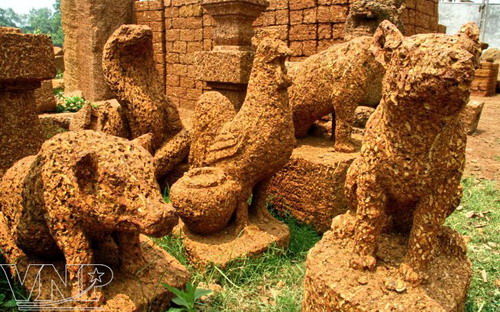
He said that mining and processing laterite requires diligence, meticulousness and the skillful hands of the workers. Over the years the technique of mining and processing laterite has basically remained the same. It is a craft so people with good health, creativity and some simple tools can open a shop. Visiting Dan’s workshop we saw rows of laterite bricks and many beautiful animal artworks made of laterite. There are even old-style lamps, pagoda gates, and delicate flower pots. Dan said: “In the old days people in this area used laterite to build houses and pigsties. Now laterite is used to make high-grade products for wealthy people.”
There is great demand for laterite in construction, especially to build pagodas or houses of an ancient style. To create a rustic, friendly and familiar beauty, laterite is the most suitable material. More and more people are spending a lot of money to buy laterite. This earns more money for the people in Binh Yen Commune in particular and Thach That District in general, enriching their life and the society as well.


